Résumé
This entry demonstrates how some of the very first novelists contributed, individually and collectively, whether consciously or inadvertently, to the rise of the new literary form while being driven by a spirit of opposition, contradiction and emulation seemingly hardly suited to foster the cooperative and collaborative environment which the development of a common literary project requires. Based on intertextual connections and apparent dialogical relationships between texts written by Daniel Defoe, Samuel Richardson, Henry Fielding and Eliza Haywood, the analysis will suggest a reading of the interactions between authors as a form of literary unsociability which contributed to the development of the novel.
Mots-clés
If Jonathan Swift's The Battle of the Books (1704), which depicted a literal battle among books located in the King’s Library, served as an allegory of an ongoing intellectual debate between the ‘Ancients’ and the ‘Moderns’, the literary ‘battle’ which subsequently opposed four major English novelists during the 1720s and the 1740s marked the beginnings of a new literary form, ulteriorly designated as the novel. Through interposed fictional works, Eliza Haywood, Daniel Defoe, Samuel Richardson and Henry Fielding thus engaged in their own ‘battle of the books’, which proved victorious: although neither side achieved an outright victory, the novel, as a genre on the rise, did emerge as the ultimate winner.
The battle of the genres: romance vs. novel
A great number of literary critics and scholars situate the emergence of the English novel during the long eighteenth century, within a more or less narrow time frame; they do however appreciate the air of novelty and innovation that permeated the English literary landscape between the 1720s and the 1740s – a period that witnessed the writing and publication of the works of Eliza Haywood, Daniel Defoe, Samuel Richardson and Henry Fielding, proclaimed, among others, as the founders of the eighteenth-century English novel.
The construction process of the new literary form during the first half of the eighteenth century was marked however by a spirit of antagonism and resistance. From the outset, the eighteenth-century novel displayed a subversive purpose, expressed through the stated intention of some writers, pioneers of a new literary craft, to conceive their works as a reaction against and rejection of the seventeenth-century French romance.
Driven by a dynamic of opposition and divergence, the novel rapidly managed to stand out and secure an enduring place for itself in the English literary landscape, becoming the object of a grand collective discourse and fostering a sense of an imagined community of writers striving to sever links with past literary forms and traditions stemming from the continent. The view of literature, or rather of the direction that literature should follow in England, as outlined in a great number of literary works published during the second half of the eighteenth century, is rather transgressive in its approach: the novel’s ambition to flout romance conventions and subvert ‘romantic’ clichés contributed to shaping the theory and practice of those considered as the founders of the genre in England.
These conflictual manifestations – taking the form of antagonism and of textual, rather than physical, confrontation – appear rather unifying, paradoxically: they constitute the driving force of literary progress, spurring the novel to develop its potential through the competitive dynamics it establishes with the romance. This view echoes an idea promoted through centuries (from Hesiod in the 8th century B.C. to Georg Simmel in the 20th, including Thomas Hobbes, Immanuel Kant and Adam Ferguson) that highlights the constructive role of conflict within the social sphere as well as its potential as a unifying force in seemingly dysfunctional social relations. We should note, however, that the notion of conflict is here constricted to a particular area of the social sphere, as we attach it specifically to the literary field; moreover, the sense of unity is not shared by antagonistic forces in this case, but rather by individuals driven by a collective desire to detach themselves, to ‘individualize’1 themselves according to their own subjectivity, and finally to surpass themselves in order to fulfill themselves and to fight a ‘common adversary’ – the French romance – that had prospered for too long across the Channel: ‘There is no stronger bond of friendship than a common enemy’,2 as Frank Frankfort Moore would say.
- 1. Immanuel Kant, Idea for a Universal History with a Cosmopolitan Aim [1784], trans. Allen W. Wood, in Günter Zöller and Robert B. Louden (eds.), Immanuel Kant: Anthropology, History and Education (Cambridge: Cambridge University Press, 2007), p. 111.
- 2. Frank Frankfort Moore, A Trial Marriage (New York: Empire Book Company, 1907), p. 9.
The ‘battle of the books’: unsociable literary interactions
Affirming that English novelists during the first half of the eighteenth century shared ‘bonds of friendship’, or a certain sense of unity, would be fairly inaccurate and illusory however, if we consider the rather conflictual literary and ideological interactions that accompanied the construction process of the novel. And yet, there is a form of unity and togetherness in construction (the prefix con- being derived from the Latin cum, meaning ‘with, together’), as it requires the association and cooperation of different part(ie)s to create a complex and functional whole; in the same way, there is a form of socialisation in conflict – conflict being, in itself, a form of socialisation according to Simmel3 – since it implies that the individual comes in contact with other individuals, and while they may not share common beliefs, they do share a keen interest in a common project.
- 3. According to Simmel’s syllogistic reasoning, ‘If every reaction among men is a socialization, of course conflict must count as such, since it is one of the most intense reactions, and is logically impossible if restricted to a single element.’ Georg Simmel, ‘The Sociology of Conflict. I’, trans. A. W. Small, American Journal of Sociology (vol. 9, n° 4, January, 1904), p. 490.
The common project consists, here, in the joint formulation of a ‘new species of writing’ (to quote Samuel Richardson’s famous phrase) that could claim the degree of consistency, recognition and legitimacy required to ensure its persistence and prominence on the literary stage. This awareness of alterity, this consideration of the other’s position and thus this form of reciprocity and mutual dependence enables conflict to become a socialising agent, paradoxically, and contributes to the emergence of a new form of sociability, founded not on bonds of sympathy, philia or a spirit of benevolence, but rather on a ‘Spirit of Faction’ which does not hinder the exchange of ideas as suggested by Joseph Addison,4 but which, conversely, stimulates and revitalizes the literary debate and creation, contributing, thus, to the progress of literary history and criticism.
- 4. Joseph Addison, The Spectator (n° 9, March 10, 1711), ed. Henry Morley, The Spectator, vol. 1 (London: George Routledge and Sons, 1891). Project Gutenberg.
The present study of literary interactions though interposed books stems from a two-fold examination of titles and dates of publication of works written during the first half of the eighteenth century: explicit intertextual connections are noticed to emerge between texts that succeed one another, sometimes very rapidly; if some titles merely allude to a previous work, suggesting an intention of plagiarism or adaptation, some others clearly adopt a parodic, satirical or polemical stance. Whether the hypertextual transformation follows, according to Gérard Genette’s typology,5 a ludic, a satirical or a serious mode, the fact that these publications forge a direct and explicit link with anterior works is rather conspicuous.
- 5. Gérard Genette, Palimpsestes : La littérature au second degré (Paris : Éditions du Seuil, 1982), p. 45.
Daniel Defoe’s third and last novel, Roxana: or, the Fortunate Mistress, published in 1724, closely followed the publication of Eliza Haywood’s Idalia; or, The Unfortunate Mistress, in 1723. The intertextual relationship is effectively signalled to the reader through the symmetrical construction of the title; Defoe renames however his heroine and alters the Homeric epithet attached to her name, while drawing attention to the polysemous nature of the word ‘fortune’: whereas Haywood’s narrative focuses on Idalia’s lack of chance when it comes to amorous affairs, Defoe insists instead on Roxana’s expanding wealth and material possessions, acquired throughout years spent as a courtesan.
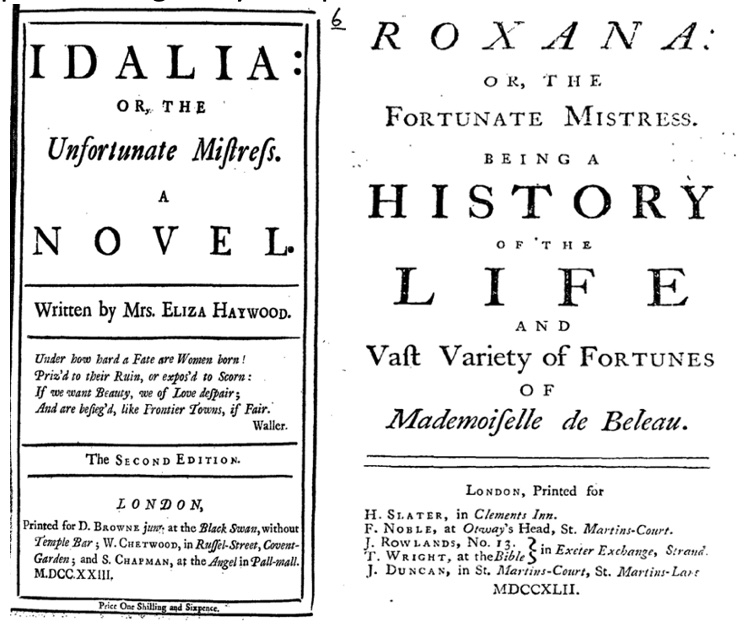
A victim of its own success, Samuel Richardson’s Pamela, or Virtue Rewarded, first published on November 6th, 1740, triggered a vast variety of fictional and non-fictional responses, ranging from sequels to parodies, and from defenses to criticisms. Perhaps the most popular and discussed response to Richardson’s novel is Henry Fielding’s An Apology for the Life of Mrs. Shamela Andrews, published on April 2nd, 1741, barely five months after the first edition of Pamela was issued – although it was rather the second edition, published February 14th, 1741, along with the six promotional letters added in the introduction of the said edition, which must have provoked Fielding’s hostile, yet humorous, reaction. Ten months after Shamela, in February 1742, Fielding reiterated his point through a significantly longer work, The History of the Adventures of Joseph Andrews, And of his Friend Mr. Abraham Adams – initially conceived as another response to Pamela, before becoming an autonomous and more ambitious prose fiction.
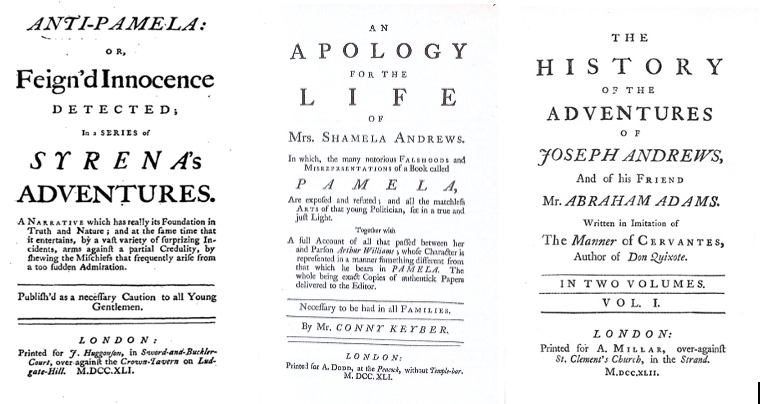
Two months after Shamela, on June 16th, Eliza Haywood enters ‘the Pamela marketplace’ by publishing Anti-Pamela; or, Feign’d Innocence Detected – a title which is even more revealing of the author’s intentions than Fielding’s. It appears that the textual exchanges between Haywood and Richardson started earlier, however, if we consider the title and plot of a novella published by the prolific authoress in 1727: The Perplex’d Dutchess; or, Treachery Rewarded recounts the story of a lady’s maid, Gigantilla, who, under the false pretense of virtue, schemes to entrap the duke of Malfi into marriage, thus becoming a duchess. Thirteen years later, Richardson chose to reward not treachery or deceit, but genuine virtue, embodied by Pamela, thus detaching himself from these amatory fictions, so popular during the 1720s, that feature amorous intrigues involving conspiracy, dissimulation and manipulation.
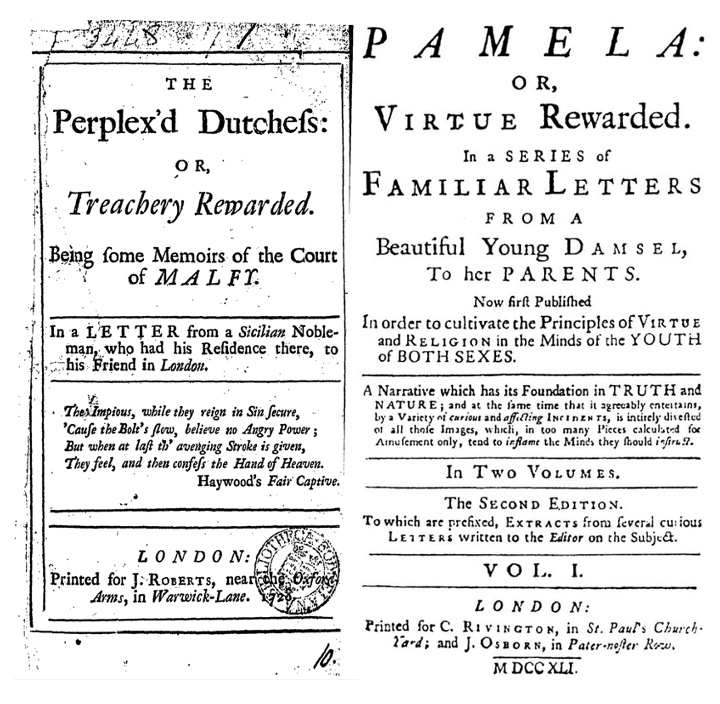
Finally, and following the same principle, The Life of Mr. Jonathan Wild the Great, published by Fielding in the third volume of Miscellanies in 1743, redirects the reader towards another account of the life of the notorious criminal entitled The True and Genuine Account of the Life and Actions of the Late Jonathan Wild, often attributed to Defoe and published in 1725. Although a great number of rogue narratives recounting Wild’s adventures were published during the first half of the eighteenth century, a sentence taken from the preface to the Miscellanies implicitly alludes to Defoe’s account, not without a hint of irony. The author states: ‘[…] my Design is not to enter the Lists with that excellent Historian, who from Authentic Papers and Records, etc. hath already given so satisfactory an Account of the Life and Actions of this Great Man.’6 According to Martin C. Battestin, author of A Henry Fielding Companion, the ‘excellent Historian’ mentioned by Fielding may very well be Defoe.7
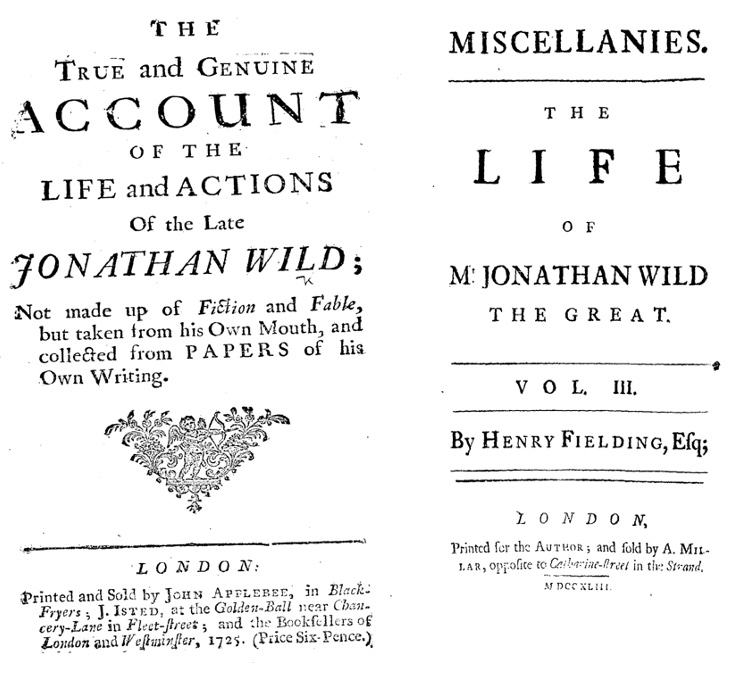
A certain form of communication seems to emerge in this dialogical encounter between texts published between the 1720s and the 1740s: the narrative replies succeed one another, revealing a strong desire to react against a previous work via a literary (and often anonymous) production but also a social predisposition that indicates a willingness to engage in a creative and critical dialogue with one’s contemporaries. The literary interactions are here constrained to four emblematic figures of the first half of the eighteenth century – Defoe, Haywood, Richardson and Fielding – a quartet whose paths would repeatedly cross, both in the private and the public spheres.
This tide of conversational writing proves to be quite contending and offensive: the authors systematically adopt fervent and categorical stances and instigate more or less virulent attacks and criticism against previous works, and hence, against previous writers. The ‘apple of discord’ revolves around three main axes. The first axis is based upon ideological or moral arguments, and can be reflected in the condemnation of the corruption and moral dangers posed by the reading of novels perceived as erotic, obscene, or even pornographic: this concern was shared by numerous readers, including Fielding and Haywood, in discovering Pamela, which led to the constitution of a faction called ‘the Anti-Pamelists’, who questioned Richardson’s moral purpose as well as the didactic intention ascribed to his first novel. According to them, a witty Pamela used her naiveté and sexual virtue to trick Mr. B., her superior, into genteel marriage. Conversely – and quite ironically – the same anxiety must have fueled Richardson’s critical response to amatory fiction in general, and perhaps more particularly to Haywood’s The Perplex’d Dutchess; or, Treachery Rewarded.
While the first axis focuses mainly on novel reading and interpretation, the second one deals with novel writing: it pertains to literary analysis and takes on an aesthetic and technical dimension. As the joint stated ambition of early eighteenth-century novelists was to lay the foundations of a new ‘Species of Writing’,8 the ‘generic skeleton of the novel’9 – in Bakhtinian terms – needs to be outlined: defining features, rules and conventions, narrative norms and techniques – all prone to debate and susceptible to undergo changes in the course of the development process of the genre, so as to ensure its evolution and elevation. On the one hand, the eighteenth-century novel will have to endure the same accusations formulated against seventeenth-century romances, namely its lack of plausibility and verisimilitude. On the other, some eighteenth-century authors have condemned the ‘denial of fictionality’10 endorsed by some of their contemporaries – a tendency defined by Lennard Davis as the claim ‘that they are presenting not a fiction but a factual account of some real series of events’ (Lennard 120): it was the case of Fielding, denouncing Pamela in Joseph Andrews but also Defoe’s Robinson Crusoe in The Champion in 1740 and in The Jacobite’s Journal in 1748 (Battestin 56). From there on, the objective set for the novel consisted in admitting its fictional status and tending toward a different kind of ‘realism’, in order to effectively convey, as projected, an accurate sense of reality.
Lastly, the third axis considers the matter from an economic and sociocultural perspective and focuses primarily on the professional and financial interest gained by the authors in writing and publishing response-fictions. Although this may not constitute a bone of contention in itself, the material interest resulting from any fictional reply is inevitably correlated to the success of the initial novel, which might have led to the development of rivalries and competitive tensions in a growing literary market. Mindful of the adage ‘if you want to be read, write about what others are reading’,11 these novelists managed to take advantage of anterior productions while putting their own literary skills to their best use in order to succeed, bounce back or become part of a trend.
- 8. With the publication of Pamela, Richardson intends to ‘introduce a new Species of Writing’: see John Carroll, Selected letters of Samuel Richardson (Oxford: Clarendon Press, 1964), p. 41. Similarly, Fielding describes Joseph Andrews as ‘a Species of writing […] hitherto unattempted in our Language’: Henry Fielding, The History of the Adventures of Joseph Andrews, And of his Friend Mr. Abraham Adams [1742], ed. Douglas Brooks-Davies (Oxford: Oxford University Press, 2008), p. 8.
- 9. Mikhail Bakhtin, The Dialogic Imagination: Four Essays by M. M. Bakhtin, trans. Caryl Emerson and Michael Holquist (Austen: University of Texas Press, 1981), p. 3.
- 10. Lennard Davis, ‘A Social History of Fact and Fiction: Authorial Disavowal in the Early English Novel’, in Edward W. Said (ed.), Literature and Society: Selected Papers from the English Institute, 1978 (Baltimore and London: The Johns Hopkins University Press, 1980), p. 134.
- 11. William Beatty Warner, Licensing Entertainment: The Elevation of Novel Reading in Britain, 1684-1750 (Berkeley and Los Angeles: University of California Press, 1998), p. 242.
Therefore, the text versus text confrontation proves to be constructive: although it can be perceived as a factor of conflict and division between the different parties, its overall aim is not destructive, but rather exploratory and constructive. It pertains to a voluntary and joint process of reflection and exchange regarding novelistic writing and of research around the objectives of fiction, which develops through, and thanks to, this dynamics of rivalry and competition. This positive outcome of conflict leads to consider the construction process of the eighteenth-century English novel as an illustration of the concept of ‘unsociable sociability’ developed by Immanuel Kant in Idea for a Universal History with a Cosmopolitan Aim (1784). Kant’s theory provides an anthropological alternative to classical Aristotelian approaches to sociological theory. According to him, human nature is simultaneously animated by two contrary forces: on the one hand, a predisposition to sociability, which motivates the human being to connect with his peers and which implies that he cannot live without them; on the other, a tendency to misanthropy, manifested through the individual’s natural desire to isolate himself, to avoid his peers or to compete against them, as the idea of someone dominating or imposing power over him is unacceptable. This resistance, peculiar to human beings, is not conceived by Kant as an obstacle that could jeopardize the society however, as it is precisely what ‘awakens all the powers of the human being, brings him to overcome his propensity to indolence, and, driven by ambition, tyranny, and greed, to obtain for himself a rank among his fellows, whom he cannot stand, but also cannot leave alone.’ (Kant 111)
Stating that Fielding, for instance, cannot ‘leave Richardson alone’ could raise a smile, yet the idea that Fielding’s novelistic enterprise could not have emerged and prospered without his predecessor’s contribution to literature is worth considering: his entry into the literary field is indeed consecutive to the publication of Pamela, and emanates both from a desire to respond to Richardson’s novel and an ambition to play a part on the English literary stage along his contemporaries. In this regard, Claude Rawson states: ‘If Richardson had not existed, Fielding would have had to invent him, as an embodiment of a moral and social outlook, and a literary manner, against and through which he could define his own’12 – although Richardson had already acknowledged their association, while boasting about his contribution to Fielding’s career, in a letter sent to Lady Bradshaigh in which he comments, bitterly:
- 12. Claude Rawson, ‘Fielding’s Richardson: Shamela, Joseph Andrews and Parody Revisited’, XVII-XVIII. Bulletin de la société d’études anglo-américaines des XVIIe et XVIIIe siècles (n° 51, 2000), p. 77.
‘So long as the world will receive, Mr. Fielding will write. […] The Pamela, which he abused in his Shamela, taught him how to write to please, tho’ his manners are so different. Before his Joseph Andrews (hints and names taken from that story, with a lew and ungenerous engraftment) the poor man wrote without being read […].’ (Carroll 133)
Thus, Fielding manages to ‘obtain for himself a rank’ among fellow-writers he can hardly ‘stand’ (Richardson, on the one hand, but also Defoe, whom he summons in Jonathan Wild, or even Eliza Haywood, with whom he entertained a conflictual relationship since they had met at the Little Theatre in the Haymarket during the 1730s, when she was an actress whilst he a prolific playwright)13 but, also, whom he cannot do without, since his writing and success are intrinsic to the dialogue he establishes with his predecessors. Haywood’s response to Richardson’s novel marks her comeback to literature as well as a renewal of her writing, after a five-year pause. In exchange, Fielding’s and Haywood’s counter-fictions – among others – have certainly nourished both Richardson’s writing in general and the re-writing of Pamela in particular.
- 13. John R. Elwood, ‘Henry Fielding and Eliza Haywood: A Twenty Year War’, Anbion: A Quarterly Journal Concerned with British Studies (vol. 5, n° 3, 1973), p. 184.
Drawing on Kant’s theory of ‘unsociable sociability’, Simmel writes, some one hundred and twenty years later: ‘That which was negative and dualistic may, after deduction of its destructive action in particular relationships, on the whole, play an entirely positive role’ (Simmel 492). In light of the hostile literary interactions previously discussed, it appears that conflict, in spite of its destructive potential in particular relationships, did prove beneficial both for individual improvement and for the novelistic society as a whole.
The ‘battle of the wits’: a sequel?
The conflictual literary interactions pursued well into the 1750s, between some of the old contestants but also new ones entering the ring – although we may question whether the new series of battles was beneficial to the development of the new form.
The critical dialogue between Richardson and Fielding continued through textual allusions: Richardson’s attack upon Fielding in The History of Sir Charles Grandison (1753), which was, itself, a response to Fielding’s The History of Tom Jones, a Foundling (1749) was followed by a scathing comment directly addressed to ‘Mr. Richardson’14 in the preface of The Journal of a Voyage to Lisbon (1755). In the same way, Eliza Haywood attacked Fielding in The History of Betsy Thoughtless (1751) and the latter retaliated in his Covent Garden Journal.
- 14. Henry Fielding, The Journal of a Voyage to Lisbon [1755], ed. Tom Keymer (London: Penguin, 1996), p. 11.
In the same journal, and during the same period, Fielding would engage in a long-term dispute with a significantly higher number of authors, through a series of pamphlets attacking what he considered to be ‘the Army of Grub-street’, composed, among others, of John Hill, Christopher Smart, Bonnell Thornton and Tobias Smollett. The so called ‘Paper War’, aptly designated by Wilbur L. Cross as the ‘battle of the wits’,15 recalls according to critics Swift’s Battle of the Books mentioned in the introduction of the present entry. What started as a form of ‘friendly enmity’ between Fielding and Hill, designed to stimulate the sales of the Covent Garden Journal, would however prove fatal for the author: the multiple attacks on Fielding’s third novel, Amelia– Hill’s, but also Thornton’s, which include a fake advertisement for a parody novel entitled Shamelia, reminiscent of Shamela – may have played a significant role in his decision to put an end to his novelistic career and turn towards a different kind of literature: travel writing.
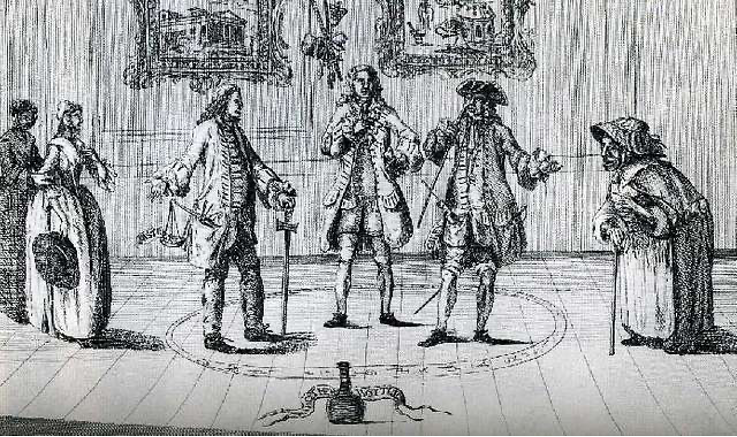
- 15. Wilbur L. Cross, The History of Henry Fielding, vol. 2 (New Haven: Yale University Press, 1918), p. 386.
Partager
Références complémentaires
Aske, Katie and Page-Jones, Kimberley (ed.), La Sociabilité en France et en Grande-Bretagne au Siècle des Lumières. L’insociable sociabilité : résistances et résilience (Paris : Le Manuscrit, 2017).
Capdeville, Valérie and Kerhervé, Alain (ed.), British Sociability in the Long Eighteenth Century: Challenging the Anglo-French Connection (Woodbridge: The Boydell Press, 2019).
Dowling, David (ed.), Novelists on Novelists (London and Basingstoke: Palgrave Macmillan, 1983).
Keymer, Thomas and Sabor, Peter, Pamela in the Marketplace: Literary Controversy and Print Culture in Eighteenth-Century Britain and Ireland (Cambridge: Cambridge University Press, 2005).
Michie, Allen, Richardson and Fielding: The Dynamics of a Critical Rivalry (Lewisburg, PA: Bucknell University Press, 1999).
Simmel, Georg, ‘The Sociology of Conflict. I’, American Journal of Sociology, trans. A. W. Small (vol. 9, n° 4, January, 1904), p. 490-525.
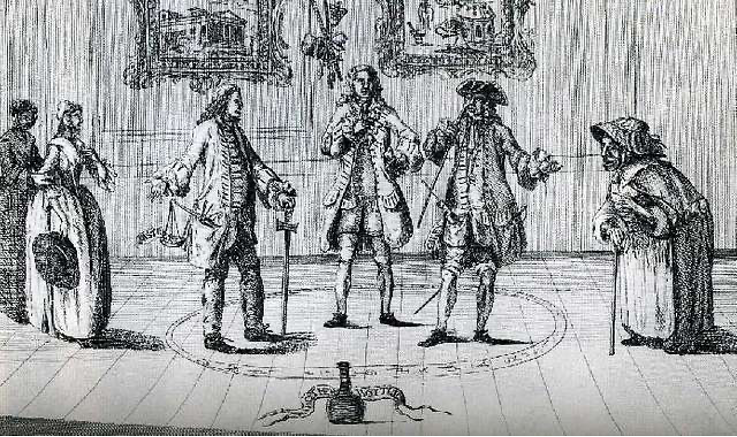
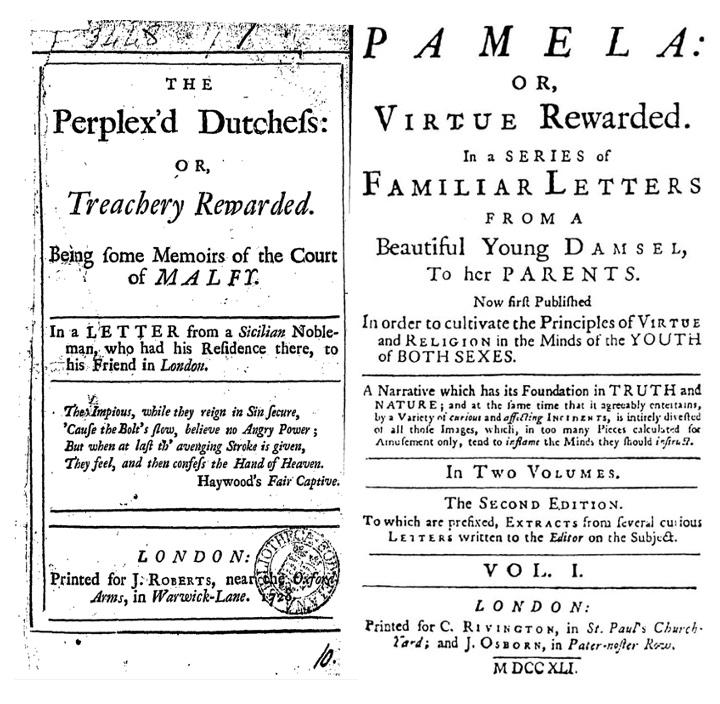
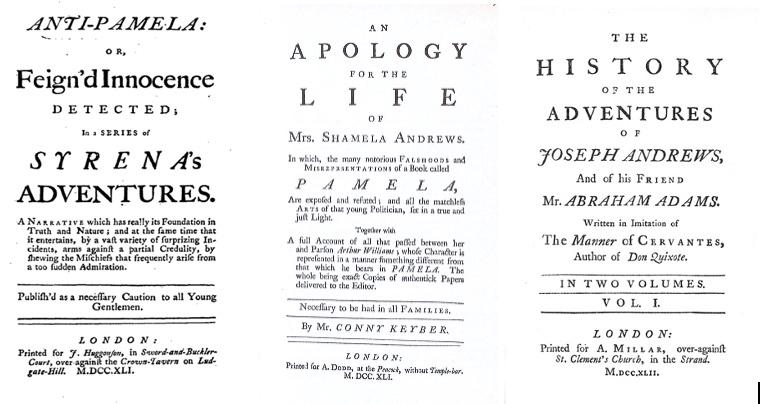
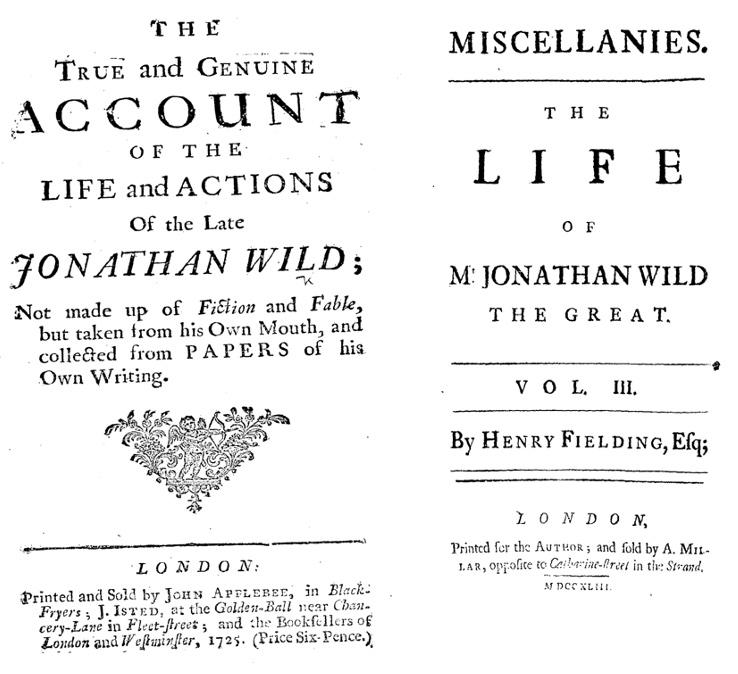
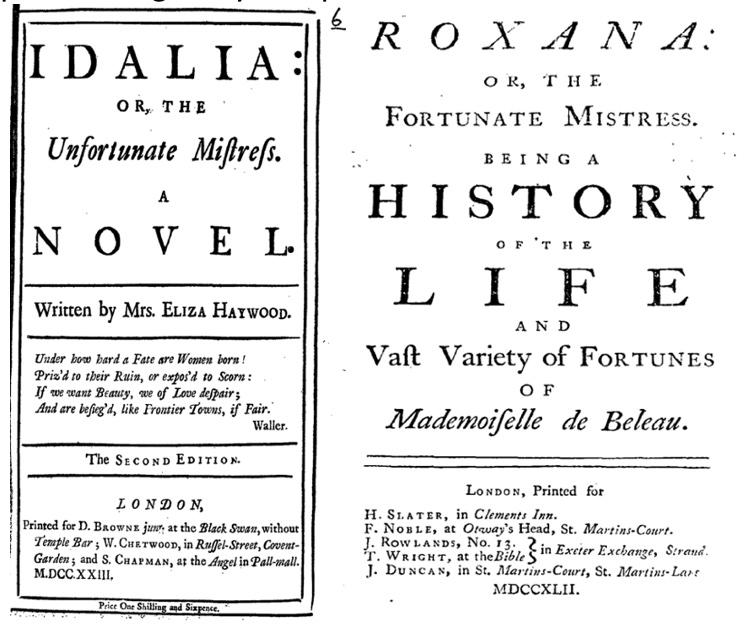
![Jonathan Swift, ‘Frontispiece to the fifth edition of The Battle of the Books’, 1710 [1704], WikiCommons, https://en.wikipedia.org/wiki/The_Battle_of_the_Books#/media/File:Battle_of_the_Books_(woodcut).jpg](/sites/default/files/styles/notice_full/public/2024-02/ENGLISH%20NOVEL%20Battle_of_the_Books_%28woodcut%29.jpeg?itok=hTP2uK_-)